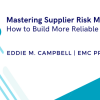The fashion industry is growing at an impressive clip. By 2030, the sector is expected to be worth $3.3 trillion and will manufacture 102 million tons of clothes and shoes. But this substantial growth hasn’t come without a cost. Six years after the Rana Plaza disaster – the fashion industry’s day of reckoning when a factory for over a dozen major brands collapsed and killed 1,000 people – observers and analysts are left wondering whether the industry has made any progress on sustainable sourcing in fashion.
Labor and human rights have long been a problem in clothing production, but they aren’t the only Corporate Social Responsibility (CSR) risks the fashion industry faces. The cost of clothing waste on the environment is also prevalent: 17 billion items are returned to retailers every year, emitting a total of 4.7 million metric tons of CO2. And with global garment production doubling over the last 15 years, 65% of excess garments end up in landfills or are incinerated, releasing toxins into the environment.
Brands have made progress in addressing these issues – Reformation, Everlane, Athleta, H&M’s Conscious clothing line and more have created lines that limit negative impact – but there’s still room to grow. Today’s consumers want to both look good and feel good about what they’re buying – which means delivering products and services to market that aren’t just fashionable but are also created responsibly and ethically. Sustainability should not have to be sacrificed in the pursuit of style – and the key to delivering on both promises lies in sustainable procurement practices.
Every Trend Starts Somewhere
The “fast fashion” model of producing clothing as quickly as possible and at the lowest cost perpetuated sustainability issues already present in a complex and global apparel supply chain. A general lack of visibility and transparency can lead to problems with forced labor, corruption, environmental issues and more for any company, but the models deployed by fashion brands to keep up with new styles quickly has made it even harder on supply chain and sustainability teams to address these risks.
The supply chain accounts for more than 80% of global greenhouse-gas emissions and 90% of impacts on resources like air, land, water, biodiversity and more. Often CSR issues lie deep in supply chains, making it hard to address with traditional procurement programs. In fact, according to the Sustainable Procurement Barometer study, only 15% of organizations said they have complete supply chain visibility into the CSR and sustainability performance of both tier one and two suppliers, and only 6% reported full visibility into tier three suppliers and beyond.
Covering Your Categories
Thus the supply chain is the source of many CSR risks and the best place to scale up the fight to improve sustainability issues. And procurement is in an ideal position to lead the charge – not only on product and raw material, but also the critical risk area of indirect categories such as packaging, services, logistics, maintenance and many others in the “long tail” of indirect spend. Integrating sustainability into relationships with suppliers and other supply chain participants and can encourage better behavior across the board.
Examining overall supplier business practices and sustainability performance leads buying organizations to high-performing supply partners that are more apt to collaborate on tackling CSR issues that arise, or creating innovative products that are both sustainable and fashionable. This collaboration benefits every party involved:
- Consumers get a product that’s stylish and sustainable – making them look and feel good when wearing it.
- Buying companies get the benefit of delivering an innovative product and securing customer loyalty because they’re solving a complex market need – and that’s good for business.
- Suppliers benefit because they have proven to be a trusted business partner that can collaboratively solve problems and deliver on the needs of the buying organization – meaning they’re more apt to get repeat business from that buying organization.
Although the industry has made progress in sustainability since Rana Plaza, specifically moving beyond conducting factory audits alone, which weren’t enough to ensure employee safety – as evidenced by the fact Rana Plaza had been audited right before the collapse – there’s still room for improvement. Factories in India and Bangladesh are frequently inspected, which is a good step, but given apparel is sourced globally, to truly tackle CSR risks, having a complete and holistic view of where all potential threats lie across the world is paramount.
Mapping supplier risk across both direct categories – the materials used in products such as cotton, dye, etc. – and indirect categories – including services and packaging – is the only truly effective way to get this insight and the industry needs to make this the new systematic approach. Many industry initiatives today only focus on mapping direct categories, but the sustainability of indirect categories such as supplies and services that support the business and packaging that gets the product to the end-consumer are also key parts of a company’s footprint and should be taken into consideration. Screening for risks, assessing supplier performance in mitigating the threats and collaboratively applying resources to address the issue in a targeted way will enable companies to make better sustainability decisions and drive improvements across all categories.
The fashion industry is taking the steps necessary to become more sustainable and offer consumers the sustainable, yet fashionable product options they’re demanding, but given that CSR risks are such complex issues, no company can do it alone. As an industry, we need to work together to not only implement sustainable procurement practices, but make them the standard, and drive creativity and innovation in product development that brings about lasting change.
Region:









